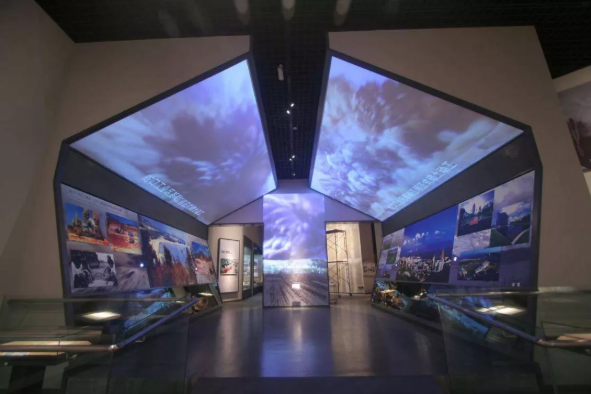The Evolution of Multimedia Interaction
As the concept of “E+ connectivity” continues to spread across industries, multimedia and virtual interaction technologies have become central to how companies engage audiences.
In digital exhibition halls, interactive projection has emerged as a low-barrier, intuitive, and visually engaging technology that merges entertainment, education, and innovation into one seamless experience.
Modern visitors no longer just watch an exhibition — they participate in it.
By integrating motion sensing, projection mapping, and LiDAR interactivity, multimedia halls are redefining how brands and institutions tell stories, showcase products, and connect with their audiences.

Why Interactive Projection Is So Effective
Enterprises and museums alike have recognized that interactive projection delivers an exceptional balance of entertainment and practicality.
It grabs attention, enhances visitor engagement, and turns traditional exhibition spaces into memorable marketing experiences.
Unlike static displays, interactive projections respond instantly to movement and gestures — encouraging curiosity, creativity, and play.
And with CPJROBOT’s POE LiDAR technology, these installations become smarter, more accurate, and easier to maintain.
Key Advantages of Interactive Projection in Exhibition Halls
1. Floor Interactive Projection

A floor interactive projection system can transform any plain floor area into an engaging interactive zone where visuals and effects respond to visitor movement in real time.
Highlights:
- Converts empty floor spaces into dynamic experiences
- Simple integration with modular setup and control systems
- Supports customizable shapes and interaction zones
Powered by CPJROBOT POE LiDAR:
- Multi-touch radar sensing detects multiple visitors simultaneously
- 270°–360° coverage ensures smooth tracking with no blind spots
- Automatic calibration makes setup quick and maintenance-free
This makes floor projections perfect for museum entrances, trade shows, retail stores, and public atriums.
2. Wall Interactive Projection

Wall-based projection systems go beyond traditional touch screens, enabling large-scale, multi-user interaction without physical contact.
Benefits:
- Supports multiple projectors for wide or custom-shaped walls
- Allows simultaneous interaction by multiple users
- Frees design from size or location limitations
When equipped with CPJROBOT’s LiDAR, the wall projection becomes more responsive — detecting gestures, swipes, and motion accurately, even in bright lighting conditions.
This creates an immersive visual storytelling wall ideal for corporate showrooms, brand pavilions, and educational exhibits.
3. Rear Projection (Back Projection Interaction)
Rear interactive projection turns any transparent or semi-transparent surface into a responsive interactive display.
It combines precise touch or gesture tracking with visual projection, allowing visitors to interact through the surface.

Features:
- Supports both touch-based and non-contact interaction
- Tracks motion dynamically — interaction points can move freely across the image
- Captures audience attention with its futuristic aesthetic
With CPJROBOT POE LiDAR, rear projection systems achieve millimeter-level accuracy and instant response, perfect for museums, art installations, or high-end retail showcases.
The CPJROBOT Advantage: Smart POE LiDAR Technology
CPJROBOT’s POE LiDAR is designed for the next generation of interactive projection.
Unlike camera or infrared systems, LiDAR uses laser time-of-flight technology to achieve high-precision spatial sensing, unaffected by ambient light or reflections.
Key Technical Advantages
- Multi-touch radar interaction: Supports many users at once with no signal interference
- PoE Power Supply: One Ethernet cable for both power and data — safe, clean installation
- Auto Calibration: Instantly adjusts to any wall, floor, or ceiling layout
- Ultra-Wide Detection Angle: 270° or 360° sensing range covers large environments
- Stable Under Bright Light: Works in daylight and high-reflection exhibition settings
By combining these capabilities, CPJROBOT enables immersive projection systems that are more reliable, scalable, and easier to deploy — making every exhibition hall smarter and more interactive.
Applications Across Industries
Interactive projection powered by CPJROBOT POE LiDAR is now widely used in:
- Science & Technology Museums: Interactive learning experiences
- Corporate Showrooms: Product demos and brand storytelling
- Retail & Shopping Centers: Immersive digital advertising
- Art Installations: Creative motion-responsive exhibits
- Theme Pavilions & Public Spaces: Large-scale interactive entertainment zones
Each installation enhances audience engagement, encourages participation, and boosts social media visibility — turning every visitor into a storyteller.
Frequently Asked Questions (FAQ)
Q1: What makes CPJROBOT POE LiDAR different from infrared or camera systems?
A: LiDAR uses light pulses to measure distance with extreme accuracy, delivering stable, low-latency performance even under bright lighting — unlike cameras, which can suffer from reflection or shadow interference.
Q2: Can multiple LiDAR sensors be combined for large exhibition spaces?
A: Yes. CPJROBOT supports multi-sensor cascading to cover extra-wide or irregularly shaped areas seamlessly.
Q3: Is the installation process complicated?
A: Not at all. With PoE power and automatic calibration, installation is fast and maintenance-free — no manual alignment or separate power supply required.
Q4: Can CPJROBOT’s LiDAR work with reception or navigation robots?
A: Absolutely. CPJROBOT’s POE LiDAR and service robots can share data networks, allowing synchronized movement detection, guest greetings, and smart navigation.
Conclusion
Interactive projection is revolutionizing multimedia exhibition design — turning passive viewing into active engagement.
From floors and walls to transparent displays, these technologies transform how audiences experience stories, brands, and environments.
With CPJROBOT’s POE LiDAR sensors and reception & navigation robots, exhibition halls can achieve true multi-touch radar interaction, effortless calibration, and immersive digital storytelling — creating smart spaces that connect people and technology seamlessly.







